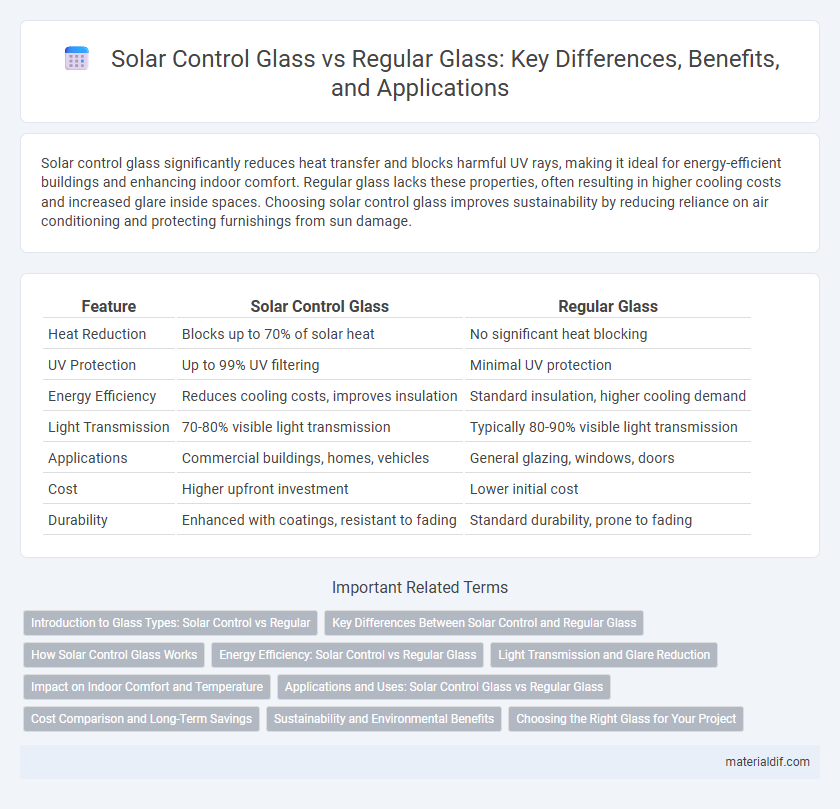Solar control glass significantly reduces heat transfer and blocks harmful UV rays, making it ideal for energy-efficient buildings and enhancing indoor comfort. Regular glass lacks these properties, often resulting in higher cooling costs and increased glare inside spaces. Choosing solar control glass improves sustainability by reducing reliance on air conditioning and protecting furnishings from sun damage.
Table of Comparison
| Feature | Solar Control Glass | Regular Glass |
|---|---|---|
| Heat Reduction | Blocks up to 70% of solar heat | No significant heat blocking |
| UV Protection | Up to 99% UV filtering | Minimal UV protection |
| Energy Efficiency | Reduces cooling costs, improves insulation | Standard insulation, higher cooling demand |
| Light Transmission | 70-80% visible light transmission | Typically 80-90% visible light transmission |
| Applications | Commercial buildings, homes, vehicles | General glazing, windows, doors |
| Cost | Higher upfront investment | Lower initial cost |
| Durability | Enhanced with coatings, resistant to fading | Standard durability, prone to fading |
Introduction to Glass Types: Solar Control vs Regular
Solar control glass incorporates a special coating that reflects and absorbs solar radiation, reducing heat gain and enhancing energy efficiency in buildings. Regular glass, typically clear or tinted, lacks this advanced coating and allows more solar heat to pass through, increasing cooling demands. The choice between solar control and regular glass significantly impacts indoor thermal comfort and energy consumption.
Key Differences Between Solar Control and Regular Glass
Solar control glass significantly reduces heat transmission by reflecting and absorbing solar radiation, thereby enhancing energy efficiency and indoor comfort. Unlike regular glass, which allows a higher percentage of solar heat to pass through, solar control glass incorporates specialized coatings or tints that block ultraviolet (UV) rays while maintaining natural light levels. This makes solar control glass ideal for reducing cooling costs and minimizing glare compared to standard clear glass.
How Solar Control Glass Works
Solar control glass incorporates a special coating or embedded metallic layers that reflect and absorb solar radiation, significantly reducing heat transfer through windows compared to regular glass. This technology minimizes ultraviolet (UV) and infrared (IR) radiation penetration, enhancing indoor comfort and energy efficiency by lowering air conditioning demands. Unlike standard glass, solar control glass maintains high visible light transmittance while effectively blocking excessive solar heat gain.
Energy Efficiency: Solar Control vs Regular Glass
Solar control glass significantly enhances energy efficiency by selectively blocking solar heat and reducing cooling loads in buildings, unlike regular glass that allows more heat transfer and increases reliance on air conditioning. By minimizing ultraviolet and infrared radiation penetration, solar control glass helps maintain stable indoor temperatures and lowers energy consumption for climate control. This results in reduced utility bills and a smaller carbon footprint compared to buildings using regular glass.
Light Transmission and Glare Reduction
Solar control glass significantly reduces light transmission, allowing only 20-40% of visible light compared to regular glass, which transmits up to 80-90%. This specialized glass incorporates coatings that filter infrared radiation and minimize glare, enhancing comfort in bright environments. By limiting solar heat gain and reducing glare, solar control glass improves energy efficiency and visual clarity in both residential and commercial buildings.
Impact on Indoor Comfort and Temperature
Solar control glass significantly reduces heat gain by filtering out a large percentage of solar radiation, maintaining cooler indoor temperatures and enhancing occupant comfort. Regular glass allows more solar heat to penetrate, often resulting in higher indoor temperatures and increased reliance on air conditioning systems. This improved thermal regulation with solar control glass contributes to energy savings and a more stable indoor environment.
Applications and Uses: Solar Control Glass vs Regular Glass
Solar control glass is designed to reduce heat gain and block harmful UV rays, making it ideal for energy-efficient buildings, automotive windows, and skylights where temperature regulation is crucial. Regular glass, lacking these properties, is commonly used in standard windows, picture frames, and interior partitions without specific thermal management requirements. The application of solar control glass significantly enhances comfort and lowers cooling costs in commercial and residential architectures compared to regular glass.
Cost Comparison and Long-Term Savings
Solar control glass typically costs 20-30% more than regular glass due to advanced coatings that reduce heat transfer and UV radiation. Despite the higher initial investment, solar control glass delivers significant long-term savings by lowering air conditioning expenses and minimizing energy consumption. Over a 10-15 year period, these energy savings often offset the upfront cost difference, making solar control glass a cost-effective choice for sustainable building projects.
Sustainability and Environmental Benefits
Solar control glass significantly reduces energy consumption by blocking harmful UV rays and minimizing heat transfer, thus lowering the need for air conditioning and heating. Its enhanced thermal insulation properties contribute to decreased carbon emissions and improved building energy efficiency. Compared to regular glass, solar control glass supports sustainable building practices by promoting renewable energy use and reducing overall environmental impact.
Choosing the Right Glass for Your Project
Solar control glass significantly reduces heat gain and UV radiation, making it ideal for energy-efficient buildings and comfortable indoor environments. Regular glass lacks these advanced coatings, resulting in higher solar heat transmission and increased cooling costs. Selecting solar control glass enhances sustainability, reduces glare, and improves occupant comfort, crucial factors when prioritizing long-term energy savings and environmental impact in your project.
Solar Control Glass vs Regular Glass Infographic

 materialdif.com
materialdif.com